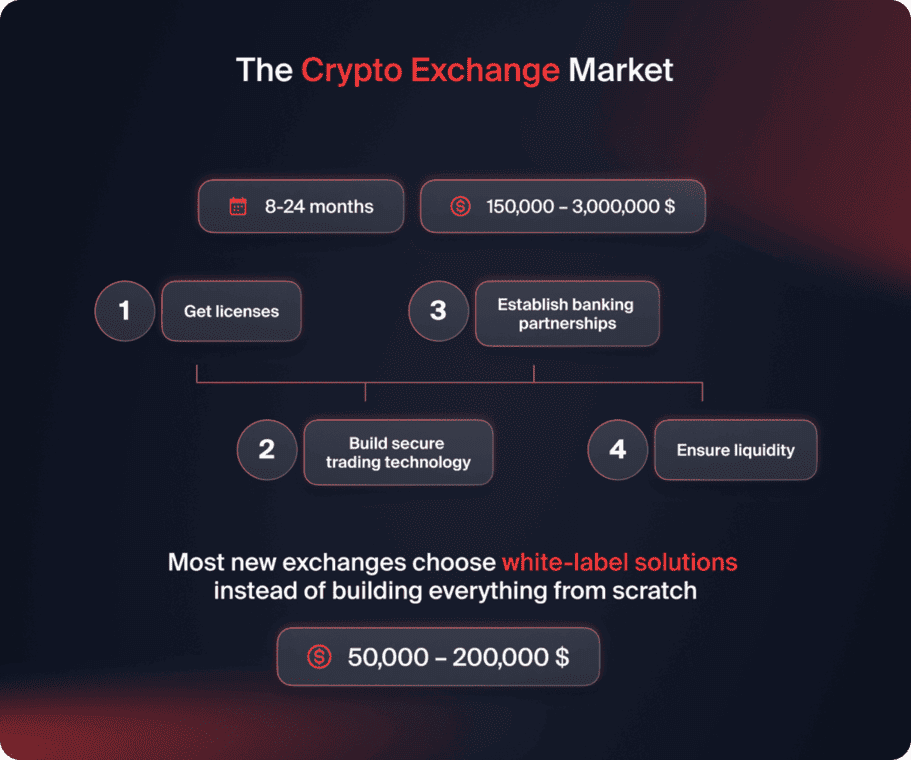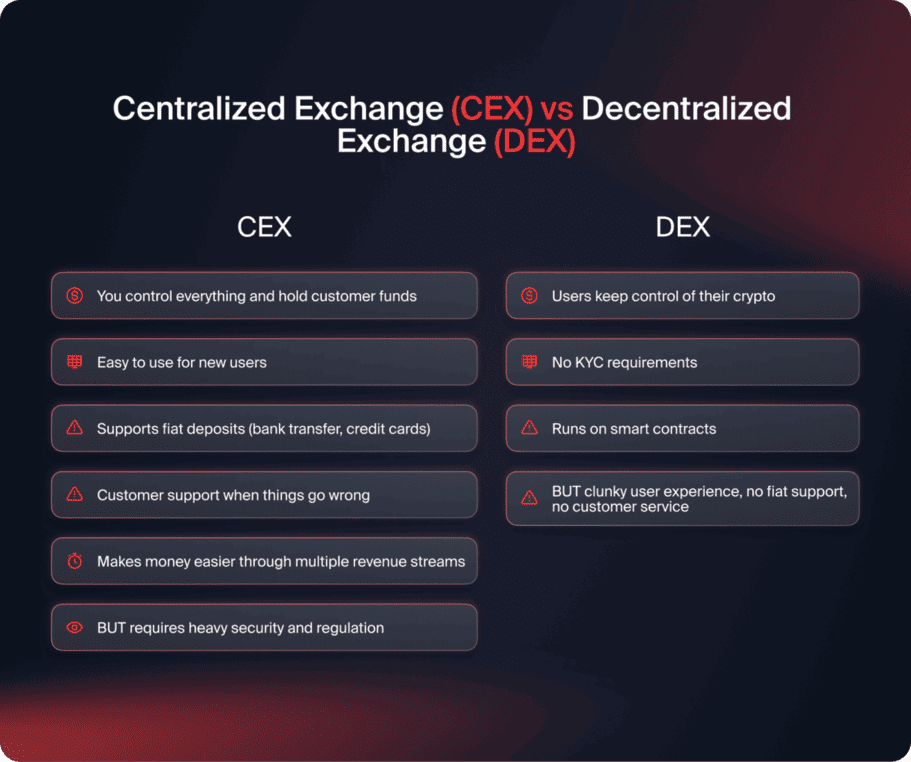
How to Build a Cryptocurrency Exchange From Scratch?
목차
암호화폐 거래소 시장이 급성장하고 있습니다. 2025년에는 글로벌 시장이 716억 달러에 이를 것으로 예상되며, 2032년에는 $260 billion에 도달할 것으로 보입니다. 2026년까지 암호화폐 시장이 9억 6천 3백만 사용자에 이를 것으로 예상되므로, 새로운 플레이어에게는 확실히 기회가 있습니다. 하지만 중요한 점은, 당신이 시장 40%를 차지하는 바이낸스와 같은 거대 기업들과 경쟁하고 있다는 것입니다. 따라서 접근 방식에 대해 스마트해야 합니다.
암호화폐 거래소를 구축하는 데는 8-24개월이 걸리며 복잡성에 따라 비용이 $150,000-$3,000,000입니다. 라이센스를 취득하고, 안전한 거래 기술을 구축하며, 은행 파트너십을 설정하고, 유동성을 확보해야 합니다. 대부분의 신규 거래소는 모든 것을 처음부터 구축하는 대신 6-12주 내에 출시하기 위해 화이트 라벨 솔루션($50,000-$200,000)을 선택합니다.

암호화폐 거래소를 구축하는 데 얼마나 비용이 드나요?
여러분의 가장 큰 질문은 아마도 암호화폐 거래소를 실현하는 데 드는 예상 비용에 관한 것일 것입니다. 아래 표를 통해 비용, 개발 시간, 그리고 여러분이 구축하고자 하는 플랫폼 유형의 기본 기능에 대한 정보를 빠르게 얻을 수 있습니다.
| 플랫폼 유형 | 개발 시간 | 추정 비용 | 하이라이트 |
| 기본 거래소 | 8–12개월 | $150,000–$300,000 | 핵심 거래 엔진, 기본 UI, 제한된 암호화폐 쌍 |
| 중간 플랫폼 | 12–18개월 | $400,000–$800,000 | 모바일 앱, 50개 이상의 코인, 콜드 스토리지, 마진 거래 |
| 기업 거래소 | 18–24개월 이상 | $1,000,000–$3,000,000+ | 파생상품, DeFi 통합, 기관 기능 |
| 화이트 라벨 솔루션 | 6–12주 | $50,000–$200,000 + 수수료 | 사전 구축 및 테스트된 시스템, 빠른 출시, 낮은 위험 |
많은 성공적인 창립자들은 화이트 라벨 시스템을 제공업체로부터 시작한 후, 비즈니스가 자리잡으면 맞춤형 기능으로 업그레이드합니다. 우리의 고객 대부분은 이것이 더 빠르고 저렴하기 때문에 이 방법을 선택합니다.

월간 운영 비용은 얼마인가요?
플랫폼 구축은 시작에 불과합니다. 매달 지불해야 할 금액은 다음과 같습니다:
- 서버 및 인프라: $5,000-$200,000 (사용자 기반이 증가함에 따라 증가)
- 유동성 제공: $20,000-$100,000+ (사람들이 실제로 거래할 수 있도록)
- 준수 및 법적: $10,000-$40,000
- 고객 지원 및 보안 팀: $50,000-$500,000
그러므로, 암호화폐 거래소를 제대로 운영하기 위해서는 최소한 월 $100,000-$500,000의 예산을 세워야 합니다.
암호화폐 거래소를 구축하는 데 얼마나 걸릴까요?
제로부터의 맞춤 개발:
- 기본 버전: 8-12개월
- 중간 복잡성: 12-18개월
- 기업급: 18-24+개월
- 라이선스에 대해 3-12개월 추가
화이트 라벨 솔루션:
- 총 6-12주 (커스터마이징 및 설정 포함)
우리가 Quadcode에서 배운 중요한 점이 있습니다: 시간은 단순히 코딩하는 것이 아닙니다. 은행 관계를 구축하는 데만 해도 3-6개월이 걸립니다. 많은 고객들이 훌륭한 플랫폼을 구축하는 데 8개월을 보낸 후, 은행들이 그들과 협력하지 않겠다고 밝혔습니다. 그래서 코딩을 시작하기 전에 법률 및 은행 업무를 먼저 진행하는 것이 큰 골칫거리를 줄이는 데 도움이 됩니다.
암호화폐 거래소에 필요한 라이센스는 무엇인가요?
운영하는 곳에 따라 크게 달라집니다.
미국:
- 연방 차원에서의 자금 서비스 사업(MSB) 등록
- 주별 자금 송금 면허 (주마다 개별적으로)
- 총액: $100,000-$500,000+ 라이센스 및 보증금만으로
유럽 연합:
- MiFID II 라이센스 또는 전자화폐 기관 허가
- 통합된 EU 시장 접근을 위한 MiCA 준수
- 더 엄격하지만, 전체 EU에 접근할 수 있습니다
아시아:
- 싱가포르, 홍콩, 일본은 특정 암호화폐 거래소 라이센스가 있습니다
- 홍콩은 최근 다섯 개의 거래소에 라이센스를 부여하여 기회를 열었습니다.
해외 옵션:
- 세이셸, 케이맨 제도 또는 몰타
- 더 빠르고 저렴한 라이센스
- 더 저렴하고 빠른 라이센스
의심이나 혼란이 있다면, 첫날부터 목표 시장에서 암호화폐 전문 변호사를 고용하는 것이 좋습니다. 규정은 매일 바뀌며, 한 번의 잘못된 행동이 당신을 폐업하게 만들 수 있습니다.
중앙 집중식 거래소를 구축해야 할까요, 아니면 탈중앙화 거래소를 구축해야 할까요?
중앙화 거래소 (CEX)
- 당신은 모든 것을 통제하고 고객 자금을 보유합니다
- 새로운 사용자에게 사용하기 쉽습니다
- 법정 화폐 입금을 지원합니다 (은행 송금, 신용 카드)
- 문제가 발생했을 때 고객 지원
- 다양한 수익원을 통해 돈을 더 쉽게 만듭니다
- 하지만 강력한 보안과 규제가 필요합니다
예시로는 바이낸스, 코인베이스, 그리고 크라켄이 있습니다.
탈중앙화 거래소 (DEX)
- 사용자는 자신의 암호화폐를 계속 제어합니다
- KYC 요구 사항 없음
- 스마트 계약에서 실행됩니다
- 하지만 불편한 사용자 경험, 법정 화폐 지원 없음, 고객 서비스 없음
예시로는 Uniswap과 PancakeSwap이 있습니다.
비즈니스를 구축하고 있다면(취미 프로젝트가 아니라면), 중앙 집중화하세요. 그곳에 사용자와 돈이 있습니다. 시장의 약 87%가 중앙 집중식 거래소입니다 사람들이 편리함을 원하기 때문입니다.

암호화폐 거래소를 구축하는 데 필요한 기술은 무엇인가요?
암호화폐 거래소를 구축하는 데 필요한 기술 스택을 분석해 봅시다.
매칭 엔진
구매자와 판매자를 연결하는 핵심 시스템입니다. 100,000건 이상의 주문을 초당 처리해야 하며, 멈추지 않아야 합니다. 거래를 위한 항공 교통 관제와 같습니다—모든 것이 이를 통과합니다.
당신이 좋아할 만한 글

당신이 필요할 것입니다:
- 시장 주문 (현재 가격으로 즉시 매수/매도)
- 지정가 주문 (목표 가격에서만 매수/매도)
- 손절매 주문 (가격이 하락할 경우 자동 매도)
- 대형 트레이더를 위한 아이스버그 주문과 같은 고급 내용
지갑과 보안
보안은 선택이 아닙니다—모든 것입니다. 한 번 해킹당하면 끝입니다. 보호를 보장하는 몇 가지 방법은 다음과 같습니다:
- 콜드 스토리지: 암호화폐의 90-95%를 물리적 금고에 오프라인으로 보관하세요. 이는 안전한 금고에 금괴를 보관하는 것과 같습니다.
- 핫 월렛: 일일 출금을 위해 5-10%를 온라인으로 유지하십시오. 사용자는 빠른 접근이 필요하지만 위험은 최소화해야 합니다.
- 다중 서명 지갑: 출금을 승인하기 위해 여러 개의 키를 요구합니다. 해커가 하나의 키를 얻더라도 자금을 훔칠 수 없습니다.
CertiK 또는 Hacken과 같은 기업의 정기적인 보안 감사는 비용을 절감하지만 파산을 방지합니다.
블록체인 연결
Bitcoin, Ethereum 및 기타 블록체인에 연결해야 합니다. 두 가지 옵션:
- 자신의 노드를 운영하세요: 최대의 제어를 제공하지만 비용이 많이 듭니다 (테라바이트의 저장 공간, 지속적인 유지보수)
- Alchemy 또는 Infura와 같은 서비스를 사용하세요: 더 쉽지만, 제3자에게 의존하게 됩니다.
대부분의 거래소는 두 가지를 혼합하여 사용합니다.
KYC/AML 준수
Sumsub 또는 Jumio와 같은 서비스를 사용하여 신원을 확인하면 사용자가 봇이나 범죄자가 되는 것을 방지할 수 있습니다. 이를 위해 필요한 것은:
- 문서 확인 (여권, 운전 면허증)
- 얼굴 인식
- 주소 확인
- 의심스러운 활동에 대한 거래 모니터링
계층화된 인증을 설정할 수도 있습니다. 소액에 대한 기본 계층(빠른 가입), 높은 한도에 대한 고급 계층(전체 문서화). 이는 모든 것을 미리 요구하는 것보다 더 많은 사용자를 전환합니다.
당신에게도 추천합니다

암호화폐 거래소는 어떻게 돈을 버나요?
암호화폐 거래소는 여러 가지 방법으로 수익을 창출하며, 이를 활용할 수 있습니다. 여기에는:
거래 수수료
암호화폐 거래소의 주요 수입원은 고객에게 부과하는 거래 수수료입니다. 여기에는;
- 거래당 0.02-0.10%
- 메이커(지정가 주문)보다 테이커(시장 주문)에게 더 많은 수수료를 부과합니다.
- 대량 거래자를 위한 할인
기타 수익원
암호화폐 거래소의 다른 수익원은;
- 출금 수수료
- 새로운 토큰에 대한 상장 수수료 ($50,000-$1,000,000+)
- 레버리지 거래로 인한 마진 이자
- 선물 및 파생상품 (매출의 40-60%를 차지할 수 있음)
- 스테이킹 및 대출 서비스
- 프리미엄 구독
성공적인 거래소는 단순히 거래 수수료에 의존하지 않습니다. 수익원이 많을수록 비즈니스가 더 안정적입니다. 다양한 수익화 전략을 이해하기 위해 중개 비즈니스 모델에 대한 가이드를 확인해 보세요.

무에서 암호화폐 거래소를 구축하는 방법: 단계별 가이드
1단계: 모든 법적 요구 사항 정리하기
코드를 한 줄도 작성하기 전에, 다음과 같은 작업을 수행하는 것이 중요합니다:
- 관할권을 신중하게 선택하세요. 일부 국가는 암호화폐를 좋아하고, 다른 국가는 금지합니다.
- 전문적인 암호화폐 변호사를 고용하세요. 일반 변호사로는 부족합니다.
- 필요한 모든 라이센스를 신청하세요. 이 과정은 3-12개월이 걸립니다.
- 은행 관계를 조기에 구축하세요. 많은 은행들이 암호화폐 사업을 거부합니다—지금부터 찾아보세요.
Quadcode에서는 고객들이 완벽한 플랫폼을 구축하는 데 8개월을 낭비한 후, 은행 계좌를 개설할 수 없다는 것을 깨닫는 경우를 보았습니다. 이는 당신이 저지르고 싶지 않은 실수입니다.
2단계: 개발 접근 방식 선택
옵션 A: 모든 것을 맞춤형으로 제작하기
- 기능에 대한 완벽한 제어
- 비용 $150,000-$3,000,000
- 8-24개월 소요
- 전체 개발 팀을 고용해야 합니다
- 높은 위험, 높은 비용
옵션 B: 화이트 라벨 솔루션
- 미리 구축되고 테스트된 준비 완료 플랫폼
- 비용 $50,000-$200,000 + 지속적인 수수료
- 6-12주 내에 출시
- 전문 지원 및 업데이트 포함
- 더 낮은 위험, 더 빠른 시장 진입
대부분의 똑똑한 창립자들은 처음에 옵션 B를 선택한 다음, 돈을 벌기 시작하면 나중에 맞춤 기능을 추가합니다.
3단계: 핵심 플랫폼 기능 구축
맞춤형이든 화이트 라벨이든, 귀하의 거래소에 필요한 것:
거래 인터페이스:
- 실시간 차트 (TradingView 라이브러리 통합)
- 모든 매수/매도 주문을 보여주는 주문서
- 속도를 위한 원클릭 거래
- 수익/손실을 보여주는 포트폴리오 대시보드
보안 시스템:
- DDoS 보호 (Cloudflare 또는 AWS Shield)
- 이중 인증
- 어디에나 암호화
- 버그 바운티 프로그램 (해커에게 범죄자가 발견하기 전에 취약점을 찾도록 지급)
결제 통합:
- 은행 송금 (와이어, ACH, SEPA)
- Simplex 또는 MoonPay와 같은 프로세서를 통한 신용/직불 카드 (3-8% 수수료로 비쌈)
- 스테이블코인 (USDT, USDC) 법정화폐 대안
4단계: 유동성 정리
유동성은 항상 구매자와 판매자가 있다는 것을 의미합니다. 유동성이 없으면 거래소는 텅 비어 있는 것처럼 느껴지고, 거래는 공정한 가격에 실행되지 않습니다.
유동성을 확보하는 방법:
- 초기에는 시장 조성 봇을 사용하세요 (이들은 주문서를 채우기 위해 주문을 합니다)
- Jump Trading 또는 Wintermute와 같은 기관 시장 조성자와 파트너십을 맺으세요
- BTC/USDT 및 ETH/USDT와 같은 인기 있는 쌍으로 시작하세요.
- 유동성 제공을 위해 월 $20,000-$100,000+ 예산
유동성을 가게에 재고가 있는 것처럼 생각해 보세요. 빈 선반은 판매가 없다는 것을 의미합니다.
단계 5: 모든 것을 철저히 테스트하세요
먼저 제한된 사용자에게 베타 버전을 출시하세요. 실제 조건에서 테스트하세요:
- 귀하의 시스템은 갑작스러운 거래 급증을 처리할 수 있습니까?
- 인터넷 연결이 끊기면 어떻게 되나요?
- 출금 과정에 버그가 있나요?
- 모바일 앱이 원활한가요?
공식 개방 전에 모든 것을 수정하세요. 출시 시 한 번의 큰 실패가 있으면 신뢰를 회복하기 어려울 것입니다.
6단계: 출시 및 마케팅
소프트 론치: 작은 사용자 그룹에 공개하고, 모든 것을 모니터링하며, 문제를 해결합니다.
그런 다음 마케팅과 함께 전체 출시:
- 암호화폐 뉴스 사이트의 콘텐츠
- 유튜브 암호화폐 채널
- 트위터/X 암호화폐 커뮤니티
- 상금이 있는 거래 대회
- 추천 보너스
모든 것을 추적하세요:
- 거래량
- 사용자 가입
- 수익
- 시스템 성능
- 고객 불만
암호화폐 거래소 운영의 가장 큰 위험은 무엇인가요?
- 보안 위반: 한 번의 해킹으로 수억 원의 피해를 입을 수 있습니다. Mt. Gox는 850,000 비트코인을 잃었습니다. 보안은 선택 사항이 아닙니다.
- 규제 변화: 정부는 새로운 규제로 당신을 하룻밤 사이에 중단시킬 수 있습니다. 항상 규정을 준수하세요.
- 유동성 문제: 사용자가 공정한 가격으로 거래할 수 없다면, 경쟁업체로 떠날 것입니다.
- 은행 관계 손실: 은행 계좌를 잃는 것은 법정 화폐 입금이 없음을 의미합니다. 게임 끝.
- 변동성 동안의 기술적 실패: 비트코인이 1시간에 20% 하락하고 귀하의 사이트가 다운되면, 사용자들은 화가 날 것입니다.
처음부터 만들까요, 아니면 화이트 레이블을 사용할까요?
사실은 이렇습니다: 만약 당신이 $1,000,000 이상의 예산과 18개월 이상의 여유가 없다면, 완전히 처음부터 시작하는 것은 더 이상 의미가 없습니다.
화이트 라벨을 고려하세요:
- 당신은 빠르게 출시하고 싶습니다 (몇 주, 몇 년이 아닌)
- 검증된 기술을 원하십니다
- 당신은 마케팅과 성장에 돈을 쓰는 것을 더 선호합니다
- 지속적인 기술 지원이 필요합니다
- 당신은 인프라가 아닌 고객에게 집중하고 싶습니다.
사용자 정의 빌드 if:
- 당신은 대규모 자금 지원을 받았습니다 (수백만 달러)
- 고유한 기능이 필요합니다
- 출시 전 18개월 이상의 시간이 있습니다
- 당신은 모든 세부 사항에 대한 완전한 통제를 원합니다
대부분의 성공적인 새로운 거래소는 화이트 라벨로 시작하여 비즈니스 모델을 입증한 다음 점진적으로 맞춤형 기능을 추가합니다. 이것이 스마트하고 저위험 전략입니다.
결론
암호화폐 거래소를 구축하는 것은 복잡하지만 확실히 가능합니다. 핵심은 접근 방식에 대해 스마트하게 생각하는 것입니다. 화이트 라벨 솔루션이 존재할 때 처음부터 만들며 시간을 낭비하지 마십시오. 보안에 타협하지 말고 법적 및 은행 설정을 건너뛰지 않도록 하십시오.
우리의 경험에 따르면, 우리는 성공적인 출시와 비용이 많이 드는 실패 사이의 차이를 보았습니다. 승자는 먼저 규정 준수에 집중한 다음 기술에 집중하고, 실제 사용자로부터 배우기 위해 조기에 출시합니다. 패자는 수년 동안 고립된 상태에서 개발한 다음 시장이 변했거나 규제가 그들의 비즈니스 모델을 허용하지 않는다는 것을 발견합니다.
FAQ
네, 당신은 자신의 암호화폐 거래소를 만들 수 있습니다. 그렇게 하려면 적절한 라이센스, 자본 및 맞춤 개발을 위한 충분한 시간(바람직하게는 12-24개월)이 필요합니다. 또한 화이트 라벨 솔루션을 사용하여 저렴하고 빠르게 암호화폐 거래소 플랫폼을 만들 수 있습니다.
The cost of building a crypto exchange depends on the type of platform being built. Basic platforms from scratch cost between $150,000 and $300,000, medium complex platforms cost between $400,000 and $800,000, while enterprise-grade exchanges cost between $1,000,000 and $3,000,000.
Custom development takes 8-12 months for basic exchanges, 12-18 months for medium platforms, and 18-24+ months for enterprise solutions. Add another 3-12 months for licensing and regulatory approval. White-label solutions launch in just 6-12 weeks, including customization.
When building your crypto exchange, you must fully comply with relevant laws and regulations guiding your operations within your preferred jurisdictions. Such laws and regulations include licensing and registration, KYC/AML, data privacy, token listing, and taxation, etc.
업데이트:
2025년 11월 13일




